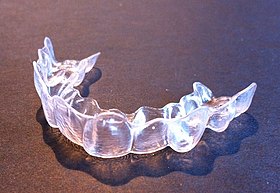Effectiveness and Uses of Clear Aligners
- A 2014 systematic review found insufficient evidence to determine the effectiveness of clear aligners.
- Clear aligners are likely useful for moderate front-teeth crowding, but less effective for teeth that are too far forward or backward, or rotated in the socket.
- Cases of relapse of the anterior teeth have been found with clear aligners compared to conventional braces.
- A 2013 Cochrane review found no high-quality evidence for managing the recurrence of lower-front-teeth misalignment.
Application and Manufacturing of Clear Aligners
- Treatment begins with diagnostic x-rays, photographs, and capturing the patient's bite, teeth, and gums.
- Dental impressions are scanned to create a digital 3D representation of the teeth.
- Technicians use software programs to move the teeth to the desired location and create aligners.
- Each aligner moves teeth between 0.25 to 0.33 millimeters.
- Additional rounds of aligners, known as Refinements, may be necessary for desired tooth positions.
- Aligners are modeled using CAD/CAM software and manufactured using stereolithography.
- The molds for aligners are built in layers using a photo-sensitive liquid resin cured by a laser.
- Clear aligners are made from an elastic thermoplastic material that applies pressure to move teeth.
- Tooth-colored composite attachments may be bonded onto certain teeth for rotation or pulling down.
- Attachments or interproximal reduction may be used to facilitate movement or improve fit.
Treatment Process and Brands of Clear Aligners
- Each aligner is worn for 22 hours a day for one to two weeks.
- The average treatment time is 13.5 months, varying based on the complexity of teeth movements.
- Aligners are removed for brushing, flossing, and eating, but hot liquids should be avoided.
- After treatment, patients are advised to wear a retainer at night.
- Invisalign, manufactured by Align Technology, has treated over 12.2 million patients.
- Align Technology was founded in 1997 by Zia Chishti and sales began in the U.S. in 1999.
- Orthoclear, developed by Zia Chishti after leaving Align Technology, resulted in legal disputes and a settlement in 2006.
- ClearCorrect, established in 2006, was named the fastest-growing health company in America in 2011.
- ClearCorrect's align system has been used to treat about 80,000 patients.
- SmileDirectClub was launched in 2014 as an alternative to in-office clear aligners.
- Smile White is a UK-based company that offers clear aligners.
Direct-to-Consumer Clear Aligner Services
- Following SmileDirectClub, multiple companies provide aligner treatment to patients through mail and digital platforms.
- The American Association of Orthodontists released a consumer alert explaining potential risks associated with such services.
Controversies, Legal Issues, and Costs
- Lawsuits have been common in the clear aligner market.
- ClearCorrect and Align Technology had patent disputes, resulting in an agreement and payment of $20 million.
- Align Technology required doctors prescribing Invisalign to complete a minimum number of cases and training, leading to certifications being suspended and a class action lawsuit.
- ClearCorrect filed a declaratory judgment against Align Technology, claiming invalid patents.
- Align Technology filed lawsuits against ClearCorrect, alleging unfair practices and patent infringement.
- The cost of clear aligners is typically lower than all-metal braces.
- Prices are influenced by factors such as treatment details, time/age of treatment, location, and the experience of the orthodontist.
- In countries like Australia, Canada, United States, and United Kingdom, prices are fairly similar at around $2,000/£1,500.
- Direct-to-consumer clear aligner companies have faced criticism and scrutiny from dental professionals.
- The American Association of Orthodontists has issued consumer alerts regarding the potential risks of using direct-to-consumer clear aligner companies.
- Invisalign, one of the leading clear aligner brands, has faced a class-action lawsuit and settlement.
This article needs to be updated. Please help update this article to reflect recent events or newly available information. (November 2023) |
Clear aligners are orthodontic devices that are a transparent, plastic form of dental braces used to adjust teeth.
| Clear aligners |
|---|
 |
|
Clear aligners have undergone changes, making assessment of effectiveness difficult. A 2014 systematic review concluded that published studies were of insufficient quality to determine effectiveness. Experience suggests they are effective for moderate crowding of the front teeth, but less effective than conventional braces for several other issues and are not recommended for children.[further explanation needed] In particular they are indicated for "mild to moderate crowding (1–6 mm) and mild to moderate spacing (1–6 mm)", in cases where there are no discrepancies of the jawbone. They are also indicated for patients who have experienced a relapse after fixed orthodontic treatment.
Clear-aligner treatment involves an orthodontist or dentist, or with home-based systems, the person themselves, taking a mold of the patient's teeth, which is used to create a digital tooth scan. The computerized model suggests stages between the current and desired teeth positions, and aligners are created for each stage. Each aligner is worn for 22 hours a day for one or two weeks. These slowly move the teeth into the position agreed between the orthodontist or dentist and the patient. The average treatment time is 13.5 months. Despite patent infringement litigation, no manufacturer has obtained an injunction against another manufacturer.

